| Article ID | Journal | Published Year | Pages | File Type |
|---|---|---|---|---|
| 10738965 | Free Radical Biology and Medicine | 2005 | 8 Pages |
Abstract
We assess the availability of plasma biomarkers to monitor the brain damage and the therapeutic efficacy of edaravone. The study consisted of 51 patients with ischemic cerebral infarcts. They were divided into 2 groups: GI (n = 24) had cortical lesions, and GII (n = 27) had lesions in the basal ganglia or brain stem. Edaravone was administered to 27 randomly selected patients (GIa, n = 13; GIIa, n = 14) and its efficacy was studied by comparing their plasma OxLDL, S-100B, and MnSOD levels to those in patients without edaravone (GIb, n = 11, GIIb, n = 13). Three days after the start of edaravone, plasma OxLDL was significantly lower in GIa than GIb patients (0.177 ± 0.024 ng/μg apoB vs 0.219 ± 0.026, P < 0.05). In GIIa patients, pre- and posttreatment plasma OxLDL was not significantly different (0.156 ± 0.013 vs 0.152 ± 0.020). In GIa patients, S-100B and MnSOD were significantly lower than in GIb patients (P < 0.05). The neurological condition at the time of discharge had recovered in GIa but not GIb patients. Ours is the first evidence to confirm the efficacy of edaravone by plasma biomarkers. In patients with cortical infarcts, edaravone reduced oxidative damage, thereby limiting the degree of brain damage.
Keywords
mAbInversion-recoveryNIH stroke scaleflow-sensitive alternating inversion recoveryoxLDLPWINIHSSDWI8-OHdG8-hydroxydeoxyguanosineMonoclonal antibodyFLAIRmiddle cerebral artery occlusion/reperfusionAcute cerebral infarctionPlasma biomarkerFree radical scavengerPerfusion-weighted imagingdiffusion-weighted imagingFree radicalsSODSuperoxide dismutaseOxidized low-density lipoprotein
Related Topics
Life Sciences
Biochemistry, Genetics and Molecular Biology
Ageing
Authors
Masaaki Uno, Keiko T. Kitazato, Atsuhiko Suzue, Kazuhito Matsuzaki, Masahumi Harada, Hiroyuki Itabe, Shinji Nagahiro,
